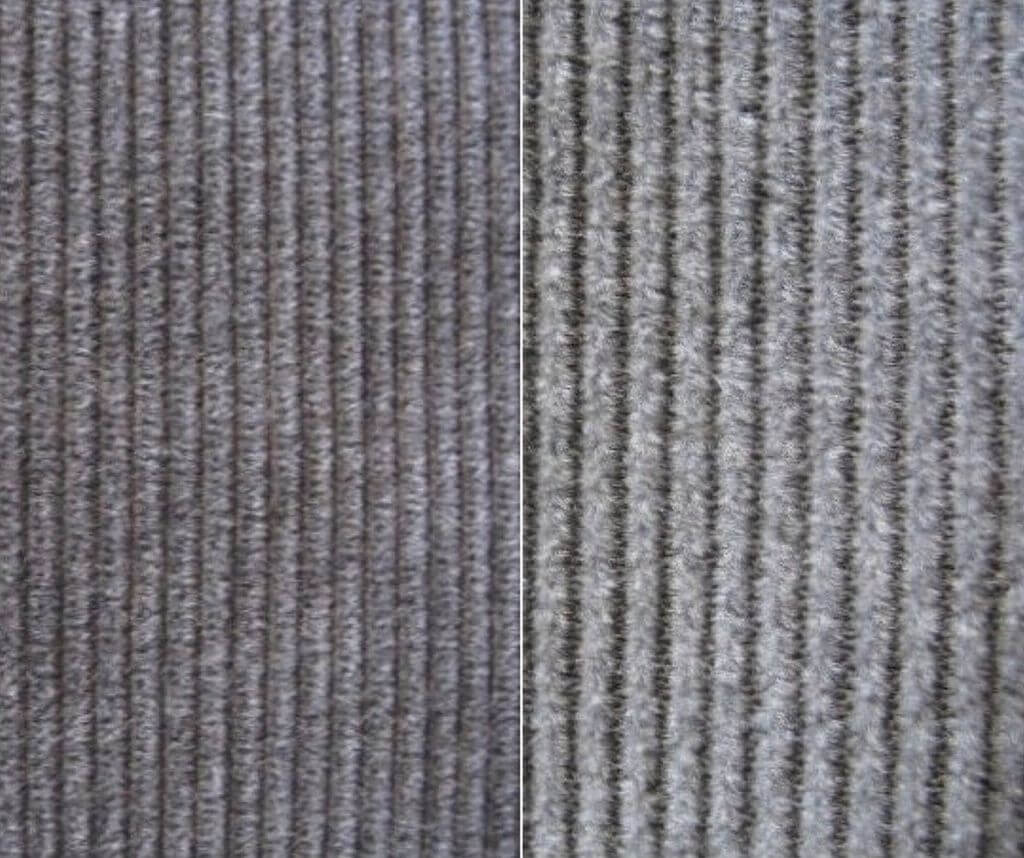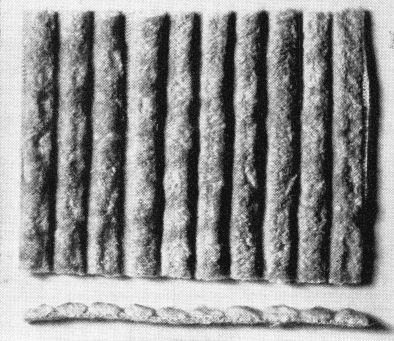Details of the use of corduroy are given in the section covering gold and silver, but there is no reason why this material should not be used by the small miner in the concentration of any sulphide ore—silver, mercury, copper, lead, antimony, and sphalerite, for example. Corduroy forms part of the concentrating equipment of the platinum ores of Transvaal, South Africa, whose value occurs
Fig. 125A.—Top and end views of corduroy. It should be laid with the high side facing the flow of pulp. Gold and sulphides are caught in the furrows between the ribs.
in the metallic state in the oxidized zone and as sulphide at depth. At a small mine in the development or even the regular production stage, corduroy could form a temporary means of saving sulphides until the mill is enlarged and other suitable concentrators are installed—jigs, tables, or flotation cells. A high recovery could not be expected, but average results should be satisfactory; the expense of building sloping tables for the corduroy and their operation would be low. Experience with an ore and the pulp flow would show how much load the corduroy will carry and how often it should be washed. Tables for average gold-quartz ores with, say, 5 per cent sulphides (pyrite and arsenopyrite, gravity 5 to 6) require a slope of 1½ inches per foot, but argentite (7), galena (7½); and cinnabar (8), may need a greater slope than chalcopyrite and sphalerite (4); stibnite (4½), and chalcocite (5½). Figure 125a shows corduroy clearly.
Corduroy as the Lowest Cost Sluice Mat
Although blanketing, canvas, sacking, porous rubber matting, and skins with the hair on have saved much gold in the past, we will confine this section on gold-saving to corduroy. The author has seen this used in plants treating 50, 1000, and 1400 tons of ore a day, catching coarse and fine gold and sulphides. The process is described as world practice in Engineering and Mining Journal, New York, for February, 1935, and in Information Circular 7085 (1939), Federal Bureau of Mines. If there is more of an interest in finding gold, then you can combine a cheap sluice mat with a cheap metal detector.
Everyone knows corduroy by sight, even if he has not worn it, although the gold-saving material differs somewhat, the ribs and the space between them being wider. Instead of copper plates, the material is laid across the tables where the plates would be and is washed in a tub or barrel once, twice, or several times a shift. Corduroy is easier to handle than plates; it catches gold regardless of the rate of a stream of pulp and is excellent for recovering sulphides. Also, no chemical reactions affect the cloth as they do plates and cause loss of gold. Acid mine water has no effect; nor have antimony, arsenic, bismuth, clay, graphite, or lead minerals. Unclassified pulp may be flowed over the material.
If panning shows an ore to contain a fair amount of coarse gold and mineral, there should be no hesitancy in using corduroy, but only experience with it will show how to place it and how often to wash it.
The slope of corduroy or blanket tables depends upon the type of ore—steep for heavy sulphides and low for clean quartz containing a little mineral—for the latter, 1 3/8 to 1½ inches per foot should be about right. Tables should be adjustable to 1 or 2 inches.
A table 4½ by 6 feet or 27 square feet, laid with three strips of corduroy or blanketing overlapping one another a couple of inches, is good for 100 tons or more of ore in 24 hours. A table 10 feet long and 28 to 30 inches wide will take care of the pulp from 5 stamps. One rule is 1 to 1½ square feet per ton per day.
As with the slope, the number of times that the cloth should be washed depends upon the gold content of the ore, also the amount of mineral. With $10 to $15 ore, carrying fine gold, once or twice a shift may be often enough; with ore of similar value, but carrying coarse gold, washing every hour or two is sometimes necessary. In general, it is advisable to wash the upper strips of corduroy more often than the lower ones.
Corduroy may be purchased in rolls or possibly in short lengths or yard.
As a rule, machinery and supply houses in mining districts handle corduroy or will get it for anyone who wants it. Corduroy concentrates are ground and amalgamated in a barrel or Berdan pan.


